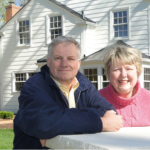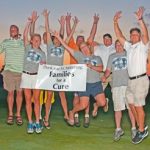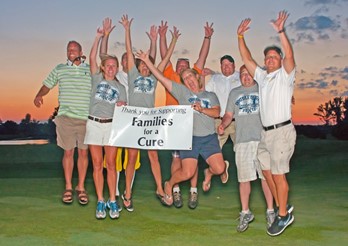Organizations and individuals who have been impacted by the disease come together to make a difference for others
 In 2009 Jane Clark and her husband Kevin, started a non-profit called Hope Hollow. At a time in their lives when most retired couples would be downsizing their homes and looking to live a simpler life, the Clarks set out on a mission to make life simpler and more comfortable for those receiving cancer treatment and their families.
In 2009 Jane Clark and her husband Kevin, started a non-profit called Hope Hollow. At a time in their lives when most retired couples would be downsizing their homes and looking to live a simpler life, the Clarks set out on a mission to make life simpler and more comfortable for those receiving cancer treatment and their families.
Jane had just recovered from her own bout of cancer (medullary thyroid cancer) and while attending a cancer support forum, she and Kevin were shocked to learn the number of people from all over the country who come to Columbus to get treatment.
Kevin said that after Jane’s thyroid cancer recovery in 2007, followed with a breast cancer diagnosis in 2010 that was thankfully diagnosed and treated early, she was determined to give back and to help others.
“Jane and I had been praying gratitude and speaking gratitude,” he said. “We needed to start living gratitude.”
The Clark’s plan started with the purchase and renovation of a larger house in Columbus which is located nearby a couple cancer treatment centers. Once the renovation was complete, they could begin providing a place to stay for individuals receiving treatment and/or their families when they couldn’t afford their own lodging.
Kevin recalls an evening when he received a call from a friend who knew of a cancer patient who was in town for their treatment and couldn’t afford a hotel. Kevin said he explained the renovation wasn’t finished and didn’t have any furniture to accommodate a stay. The friend argued a roof for shelter is all the patient was needing. That evening Kevin ran out and purchased a mattress and a bed frame . . . Hope Hollow had become a reality.
“Strangers are just friends we haven’t met yet”
More than a decade later, Hope Hollow is providing “welcome, hospitality and hope” to those in need. In addition to lodging, Hope Hollow has provided meals, transportation assistance and emotional support, at no cost, to cancer patients and their families.
According to Kevin, Hope Hollow has paid for more than 1,400 nights of lodging this year alone, in addition to the many grocery gift cards and other kinds of support. He credits their ability to help so many people to the organizations, people and businesses in central Ohio that have generously supported their mission over the years.
“I’m humbled that so many people believe in what we are doing,” he said. “Our story, and our mission is touching so many people that our donors come to us each year and ask how to help.”
Among those organizations for which Kevin expressed his gratitude is Families for a Cure (FFAC). Similar to Hope Hollow, this small, local fund-raising group was created and is led by individuals who have been directly impacted by cancer and found the inspiration to do something to make a difference for others.
Before FFAC was even an idea, Pat Puhl had created and hosted the Double Bogey Invitational (DBI), an annual golf outing that brought friends and members of the community together. As the number of participants grew over the years, his hope was to build the event it into a fund raiser to support cancer research and support programs. That day came when he met Eric Friedman for lunch. Eric had established The Malcolm and Joyce Friedman Fund for Cancer Research, a research fund he created in memory of his parents who both lost their battles with cancer.
The two got together and hosted the 2006 Double Bogey Invitational and raised more than $3,500. Three years later, the event raised more than $25,000 with a waiting list of guests wanting to participate and support their cause. It was that moment, according to Puhl, the concept of establishing Families for a Cure came about.
Along with a small, motivated group of volunteers and family members, Friedman and Puhl established the organization with the sole mission of uniting a community to raise money in support of cancer research and patient care programs through fun events and experiences.
“I’d love to tell you there was a plan behind everything we have done but that isn’t the case,” Puhl said. “We have a collective family of donors and a belief in the importance of getting involved. We create the opportunities for those individuals to connect with us and to help our mission.”
Putting the fun in fundraising
 In the years that followed, The Double Bogey Invitational became a widely recognized Families for a Cure signature event drawing more than 400 golfers each year and raising as much as $80,000 through sponsorships, donations, auctions, raffles and registration fees.
In the years that followed, The Double Bogey Invitational became a widely recognized Families for a Cure signature event drawing more than 400 golfers each year and raising as much as $80,000 through sponsorships, donations, auctions, raffles and registration fees.
With the success of the DBI, Families for a Cure leaders realized a need to build in other events and fun experiences to keep friends, supporters and the community engaged throughout the year. FFAC now hosts the Flap Jack 5K, Ladies Night, a Derby party and an annual toy drive. For the last four years, Families for a Cure has also partnered with the Hilliard Rotary Club to host an auction during its Great Debate Ohio State vs. Michigan event.
When Families for a Cure was established, Puhl said he and the members of the board believed it could raise $1 million by 2021. That goal was surpassed in 2018.
“Throughout the year we host fun experiences that bring together our family of supporters to celebrate the lives of the people we know who are battling, have battled and won as well as those we’ve lost to cancer,” Puhl said.
As the organization diversified its fund-raising activities, Puhl said the decision was also made to look beyond supporting cancer research alone but also look to support all types of cancer projects that impact all patients. “This better enables us to monitor and share the impact to our family of supporters,” he said
Every year, the Family for a Cure board reviews and discusses the many cancer research and patient care programs that apply for grants to determine how the organization can deliver the most value for the grant money it gives.
“As an organization, we pride ourselves on our ability to use the money raised from these events, add it to the donations and support we receive from our business sponsors, and make the money do work that none of us along could do. That’s the power of the family,” he added.
In addition to organizations like Hope Hollows, FFAC grants have supported dozens of organizations that work to help individuals fighting cancer or their loved ones. For example, FFAC has supported Pink Ribbon Girls, a cancer support organization that provides free healthy meals, housecleaning, rides to treatment and support to individuals and families currently fighting breast and gynecological cancers.
Flying Horse Farms a medical specialty camp that provides healing, transformative experiences for children with serious illnesses and their families free of charge has also received grants from FFAC as well as Nationwide Children’s Hospital, Ronald McDonald House Charities of Central Ohio and Feel Better Foundation to name a few others.
Families for a Cure also started its own program to help families in the community. The Allison Orlando Wood Patient Experience grant provides individuals or groups impacted by cancer with a grant to go and experience something fun to take a break from their daily reality, celebrate life and create memories.
“When you are an organization that raises funds from experiences, it would be logical that you would offer families fighting cancer an opportunity to be together and provide them with their own memorable experience,” Puhl said.
For Puhl and the rest of the Families for a Cure leadership, fundraising has always been about the experiences you can provide the people who are supporting the mission and giving them the opportunity to join in and participate every year
“Everyone has their why and we all know someone who has been personally impacted and looks for a way to make a contribution, to make a difference in their own way,” Puhl said. “Our mission is to create events and opportunities that people can come and support and enjoy themselves in the process.”

